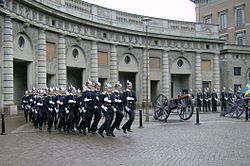- Military step
-
A Chinese PLA honor guard goosesteps.
 Stockholm Palace guards double time marching
Stockholm Palace guards double time marching
Military step or march is a regular, ordered and synchronized walking of military formations.
Contents
History
The steady, regular marching step was a marked feature of Roman legions. Vegetius, the author of the only surviving treatise on the Roman Empire's military, De Re Militari, recognized the importance of "constant practice of marching quick and together. Nor is anything of more consequence either on the march or in the line than that they should keep their ranks with the greatest exactness. For troops who march in an irregular and disorderly manner are always in great danger of being defeated. They should march with the common military step twenty miles in five summer-hours, and with the full step, which is quicker, twenty-four miles in the same number of hours. If they exceed this pace, they no longer march but run, and no certain rate can be assigned." [1]
Military marching of foot formations into a battle was a common practice in most European countries for centuries, and was even carried over into the new world as recently as the American War of Independence. Since then, it has been phased out by advances in military equipment and tactics; however, Foot drill remains an important part of military education and training.
Marching types
The following commands specify different types of marching
- Quick March: This is an instruction to begin marching at the Quick March speed with the left foot. The standard pace is 120 beats per minute with a 30in. step, although there are variances to this, based on the individual regiments, the pace given by the commander, and the speed of the band's rhythm: British light infantry and rifle regiments, for example, Quick March at 140 beats per minute, a legacy of their original role as highly mobile skirmishers. Highland Regiments, which march to bagpipe music, march at 112 paces per minute. The way the march is performed is based on the regiment's nationality. Western Bloc nations typically lift their opposite arm up to the breast pocket, kept straight and used similar to a guided pendulum. Eastern Bloc nations frequently used the Goose Step, or keep their legs straight during the entirety of the step. Both of these are actually functional, as they maintain individual pace, unit pace uniformity, and actually help the soldiers march in their relatively elevated pace. The United States command is "For-ward, MARCH." Arm movement is kept to 9 inches to the front and 6 inches to the rear (6 inches and 3 inches, respectively, in the U.S. Navy, Marine Corps, and Air Force) while marching, while the interval between ranks and files is both 40 inches. The light infantry version of the march is also used by the Spanish Legion during parades.
- Slow March: This is a ceremonial pace, used for funeral marches and when a unit's colours are marched out in front of the troops. The feet are kept parallel to the ground and the arms are never used. In the United States forces, usually only the band executes a slow march. In Spain, Latin America and the Philippines this is done during religious processions whenever a military band joins it. This march style is the official parade march in the armed forces of Bolivia and Ecuador and the military academies and schools of Venezuela, done with the goosestep during parades and ceremonies. The standard pace is 60 paces per minute.
- Half Step March or Cut the pace: This is a U.S. march pace. It is at the same tempo as Quick Time, but instead of 30 inches, the step is 15 inches.
- Double March: This is essentially a moderate jog at approximately 180 paces per minute. It creates a travel speed of approximately double that of Quick Time, designed to be used even when carrying heavy burdens. This is often erroneously used to describe a sprint or an ordinary run. The U.S. command is "Double Time, MARCH." This is also used by the elite airborne units and special forces of the National Armed Forces of Venezuela on parades and ceremonies.
- Easy March: This is an unrestricted march at approximately Quick Time. This is designed for field marches and other rough conditions, though is not used in combat areas. The U.S. command is "Route-step, MARCH."
- Mark Time: This is essentially a stationary march with the knees coming up parallel to the ground or the foot dangling six inches off of the ground. The time of what they were previously marching is kept or Quick March is used if no time is supplied. This is designed to maintain the time of large parades when portions need no forward speed, but is also used as a common punishment for physical training because of its tiring nature. United States service members move the knees upward approximately 6 inches.
- Step For -Ward or Forward or Forward, March: This causes troops marking time to resume a normal march. If it is implicitly used (as when the marking time is used to align formations or to wait for the former rank to pass when entering "Column of Route" from a depth-style formation) the (typically) Right Marker stomps his foot to signal it to the rest of the troops.
See also
References
- ^ De Re Militari, Book I: The Selection and Training of New Levies
Categories:
Wikimedia Foundation. 2010.


